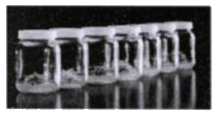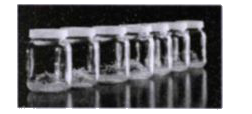An initial number of bacteria presented in a culture is 10000. This number doubles every 30 minutes. How long will it take to bacteria to reach the number 100000 ?
The correct Answer is:100 minutes
To solve the problem step by step, we will use the information given about the bacteria growth and logarithmic properties.
1. Identify the initial conditions:
- Initial number of bacteria, N0=10,000
- Target number of bacteria, N=100,000
- Doubling time, td=30 minutes
2. Set up the equation for bacterial growth:
The number of bacteria after t minutes can be expressed as:
N=N0×2ttd
Plugging in the known values:
100,000=10,000×2t30
3. Simplify the equation:
Divide both sides by 10,000:
10=2t30
4. Take logarithm on both sides:
We can use the logarithm base 2 for convenience:
log2(10)=t30
5. Solve for t:
Multiply both sides by 30:
t=30×log2(10)
6. Calculate log2(10):
We can use the change of base formula:
log2(10)=log10(10)log10(2)=1log10(2)
The approximate value of log10(2) is about 0.301, so:
log2(10)≈10.301≈3.32
7. Substitute back to find t:
t≈30×3.32≈99.6 minutes
8. Round the answer:
Since we typically round to the nearest whole number, we can say:
t≈100 minutes
Final Answer:
It will take approximately 100 minutes for the bacteria to reach the number of 100,000.
- Initial number of bacteria, N0=10,000
- Target number of bacteria, N=100,000
- Doubling time, td=30 minutes
The number of bacteria after t minutes can be expressed as:
N=N0×2ttd
Plugging in the known values:
100,000=10,000×2t30
Divide both sides by 10,000:
10=2t30
We can use the logarithm base 2 for convenience:
log2(10)=t30
Multiply both sides by 30:
t=30×log2(10)
We can use the change of base formula:
log2(10)=log10(10)log10(2)=1log10(2)
The approximate value of log10(2) is about 0.301, so:
log2(10)≈10.301≈3.32
t≈30×3.32≈99.6 minutes
Since we typically round to the nearest whole number, we can say:
t≈100 minutes
It will take approximately 100 minutes for the bacteria to reach the number of 100,000.
Topper's Solved these Questions
- BOOK - CENGAGECHAPTER - LOGARITHM AND ITS PROPERTIESEXERCISE - Exercise (Single)50videos
LOGARITHM AND ITS PROPERTIES
- BOOK - CENGAGECHAPTER - LOGARITHM AND ITS PROPERTIESEXERCISE - Exercise (Multiple)17videos
LOGARITHM AND ITS PROPERTIES
- BOOK - CENGAGECHAPTER - LOGARITHM AND ITS PROPERTIESEXERCISE - Exercise 1.513videos
LOGARITHM AND ITS PROPERTIES
- BOOK - CENGAGECHAPTER - LOGARITHM AND ITS APPLICATIONS EXERCISE - Subjective Type9videos
LOGARITHM AND ITS APPLICATIONS
- BOOK - CENGAGECHAPTER - MATHMETICAL REASONINGEXERCISE - JEE Previous Year10videos
MATHMETICAL REASONING
Similar Questions
8 pumps to to fill a tank in 1 hour 30 minutes. How long will it take, if only 6 pumps ?
View SolutionThe rate of increase of the bacteria in a culture is proportional to the number of bacteria present and it is found that the number doubles in 6 hours. Prove that the bacteria becomes 8 times at the end of 18 hours.
View Solution
Knowledge Check
- Question 1 - Select One
The rate of increase in the number of bacteria in a certain becteria culture is propotional to the number present at that time. If initiallly there are 300 bacteria and after 2 hours, the bacteria polulation is increased by 20% then after 24 houre, the number of bacteria are (log1.2=0.18232,e2.18784=8.9166)
A2675B2674C3210D3209 - Question 2 - Select One
The rate of increase in the number of bacteria in a certain bacteria culture is proportional to the number present. If in 5 hrs the number triples, then in 10 hrs, the number of bacteria present is
A18 times the originalB12 times the originalC6 times the originalD9 times the original - Question 3 - Select One
Read the following text and answer the following questions on the basis of the same: The rate of increase in the number of bacteria in a certain bacteria culture is proportional to the number present. Given that the number triples in 5 hours.

The bacteria becomes 10 times in ___________ hours.A5log7B5log10log3C5log3Dlog(1053)
The number of bacteria in a culture is x now. It becomes square of itself after one week. What will be its number after two weeks?
View SolutionBacteria increases at the rate proportional to the number of bacteria present. If the original number N doubles in 3 hours, find in how many hours the number of bacteria will by 4N ?
View SolutionRead the following text and answer the following questions on the basis of the same: The rate of increase in the number of bacteria in a certain bacteria culture is proportional to the number present. Given that the number triples in 5 hours.

If 'N' is the number of bacteria, the corresponding differential equation is ____________ .View SolutionThe rate of increase in the number of bacteria in a certain culture is propotional to the number present at that time. After 2 hours there are 600 bacteria and after 8 hours the count is 75000, then the population will be 200000 after
View SolutionA bacterial growth follows first order kinetics and it is observed that increase in bacteria is by 10% in 10 min. How long willl it take to increase bacteria concentration to double of original?
View Solution

